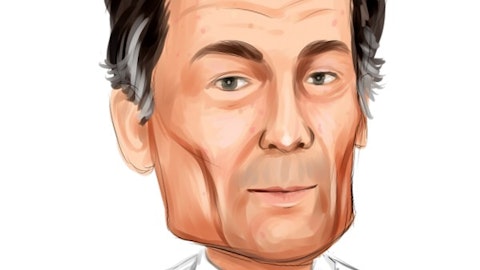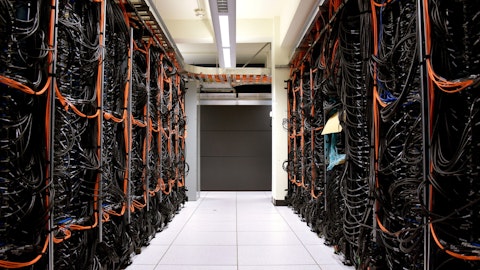Andrew Power: Thanks, Michael. So I would say on a year-over-year basis, we are — the dynamics has changed tremendously on so many fronts. Overall, the pipeline for hyperscale has continued to grow to new heights. I view the AI demand is a new wave of demand, incremental call enterprise, hybrid IT is certainly an incremental to hyperscale cloud compute. And this has all played out in the backdrop of tightening supply-demand dynamics that has called — as we’ve described, over several quarters now, moved the pendulum on pricing more and more in the favor of providers like Digital Realty. Is there a ceiling? Listen, I think we’ve seen rates run tremendously. We just, this quarter, reported in that segment North of a megawatt, call it, our highest GAAP rate ever at $145 million we are continuing to see — it’s almost like some of these customers who are often on calendar fiscal years, just like Digital Realty, wrapped up one budget cycle and got a budget refresh and came back in 2024 with the incremental appetite for demand.
These customers are seeking some of the same things. When we intersect with that demand is in our large-scale hyperscale campuses that are in our major markets and especially with larger capacity blocks that have contiguous capacity or the most sought after. And those rates continue to run in terms of what we’ve signed and where we put up quotes and I think we’re very well positioned. If you look at our footprint, you can see a lot of it on development capacity life cycle, which is just a portion of what we activate in Northern Virginia right now, but some of the other major markets as well to capture a good — more than our fair share of that demand. And lastly, I think there’s a — I think there’s a broader acknowledgment whether it is hyperscale compute or AI workloads that these customers our time to market, many of them are trying to land precious GPUs that are just enormous business opportunities for these customers.
And our rent even historically, but certainly today, plays a very small economic piece in that equation relative to their ability to launch their services and be first to market many times.
Operator: The next question comes from Jonathan Atkin with RBC. Please go ahead.
Jonathan Atkin: Yeah, I was wondering if you could talk a little bit about where we might end the year kind of in terms of leverage, where do some of the outcomes there and the role of ATM issuances, equity issuance is as part of that? Thanks.
Matthew Mercier: Sure. Thanks, Jonathan. So look, I think, you’ve seen the results of the work we’ve done in ’23, where we talked about getting down to the six times area. And the execution that not only Greg’s team on did with the transaction that we closed, but also sales on the ATM that we did early in the year and then more recently, getting to that point and actually breaking through that when you look at it on a pro forma basis, we’re at 5.8 times. And we — and so we continue to want to get down towards that 5.5 times area, which is the same messaging we’ve had since the start of ’23, and we’ve executed on that path. And we think that the plan that we’ve laid out here in terms of our guidance will enable us to get us there where we’re continuing some level of capital recycling given the broad and diverse sources of capital that we’ve got available to us.
And that’s the plan we’re going to continue to go down in terms of marching towards that 5.5% area, which is a smaller task than what we did in ’23.
Operator: The next question comes from Irvin Liu with Evercore ISI. Please go ahead.
Irvin Liu: Hi. Thank you for the question. I’ll stick to one. Andy, you mentioned demand for large blocks of capacity in several key markets such as Nova and Silicon Valley among some of the other major markets. At an aggregate level, I think, overall supply remains very low in some of these markets. But specifically for you, has lower available capacity been a gating factor for your greater than one megawatt signings performance?
Andrew Power: Thanks, Irvin. We certainly have a really great opportunity to intersect with these large capacity block needs of our customers, be it for AI or hyperscale. It is, I would say, maybe potentially unparalleled in what we can offer in Northern Virginia today in terms of available capacity in a market that’s shut down in terms of new power until 2026. But the list goes beyond that, whether it’s Dallas, Santa Clara, Paris, Frankfurt, Amsterdam, Seoul or parts of Japan, not to mention some of our joint ventures in Latin America and South Africa. We’ve taken our approach quite honestly where many of these capacity blocks for ourselves and many providers were at the early stages of development. They were at land, went pad-ready.
Shelves are coming online and just the first suites were coming online. And throughout 2023, we took a more, call it, approach whereby we didn’t go run after the first deal out of the gate for some of these customers because we knew we weren’t losing a revenue opportunity because the capacity wasn’t even being able to be moved into or at least commenced. And in hindsight, that’s proven fortuitous because as the year has played out, and certainly as 2024 has gotten off out of those gates, we’ve continue to see what we’re offering is becoming much more and more attractive to an even broader and diverse set of customers. So I don’t think we’ll be able to be late too long in 2024. We obviously now have some capacity blocks that are actually live and we can commence rent on.




